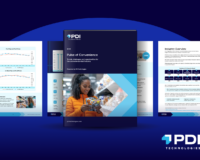
If you’re a fuel retailer, you’re no stranger to the volatility of the industry. Not only do you have to manage upstream and downstream impacts, but you’re also tasked with understanding consumer behavior and fuel buying habits.
That might not be difficult to manage during normal day-to-day operations, but what if there’s a sudden disruption to fuel supply? Or an ongoing crisis impacting demand like what we experienced during the COVID-19 pandemic?
Although you can’t predict catastrophes—or their outcomes—you can analyze potential disruptions based on decreased supply or demand to understand how best to react. Revisiting previous crisis situations can offer some guidance in how you can manage future challenges.
Key Factors in Decreased Supply
Fuel supply can run low due to a variety of reasons beyond your control. Events like the Colonial Pipeline shutdown, Hurricane Harvey hitting a refinery and slowing down production, and recent truck driver shortages have caused fuel retailers to scramble in reaction.
When supply is low, you need to ask yourself: Will there be a large spike in the cost of fuel? Will supply be deeply impacted? If it is, how will you adjust your price? And how will your customers react?
In this case, you’ll probably see your costs rising—leading to tighter margins and panic buying from people trying to wrangle some supply. When you consider the finely interwoven fuel supply ecosystem, it’s easy to see why a disruption at any point of the supply chain could lead to price swings:
- Crude oil is produced from Earth’s natural resources.
- That raw material is then transported via a pipeline or supertankers to refineries.
- Once at the refinery, that crude oil is turned into gasoline and other fuel products.
- Those finished products are then transported by truck, rail, barge, or pipeline to terminal storage facilities.
- A transport truck picks it up for delivery to local gas stations.
- The fuel needs to arrive in time to meet consumer demand.
Key Factors in Decreased Demand
We’ve seen low demand most recently due to the pandemic, where mandated lockdowns led to a significant decrease in miles driven and therefore less of a need for fuel.
But we can look back to other instances of dwindling demand like the Great Recession of 2008 and post-9/11 to know that this type of situation should remain top of mind. Typically, the fuel retail business is marked by high volumes and low margins. The age-old question for pricing managers has always been: How do you strike the ideal balance between optimizing margin and volume?
As a fuel retailer, you need to answer several questions in order to maintain the delicate balance between margin and volume:
- What is the competition doing? What are you doing in response?
- What is demand like at the macro market level? How is your volume performance in comparison?
- How is your margin? What’s happening with product costs?
A Look at the Big Picture
Your fuel pricing team is on the front lines of many challenges and disruptions to your business. They need to rely on their data to make informed decisions—especially during times of crisis. You can help alleviate any doubt they have by ensuring that their data is collected and translated accurately. By using an automated pricing solution, you can remove uncertainty and a significant of workload from your pricing team’s burden.
To overcome market-wide challenges, your solution must be able to show your team the value of stock in the ground, what time to reorder, all fuel-related costs, and overall sales. A modern pricing solution will help them track and understand your competitors (who will be rapidly evolving during times of crisis). By equipping your team to price quickly and accurately based on dynamic market conditions, you can free them up to focus on more persistent tasks—like actually managing your c-stores and delivering a better overall customer experience.
As long as you can adapt faster than the competition, challenges and chaos can lead to unique business opportunities. And, when you do experience a decrease in fuel supply or demand, you can use that time to focus on improving other areas of your business.
Start by leveraging modern, reliable technology to seamlessly integrate fuel pricing with inventory management, store-level basket analysis, and consumer loyalty programs. The better you and your team understand those interconnected dynamics, the better equipped you’ll be to weather any crisis that comes your way. To learn more, discover how PDI fuel pricing solutions can help.


